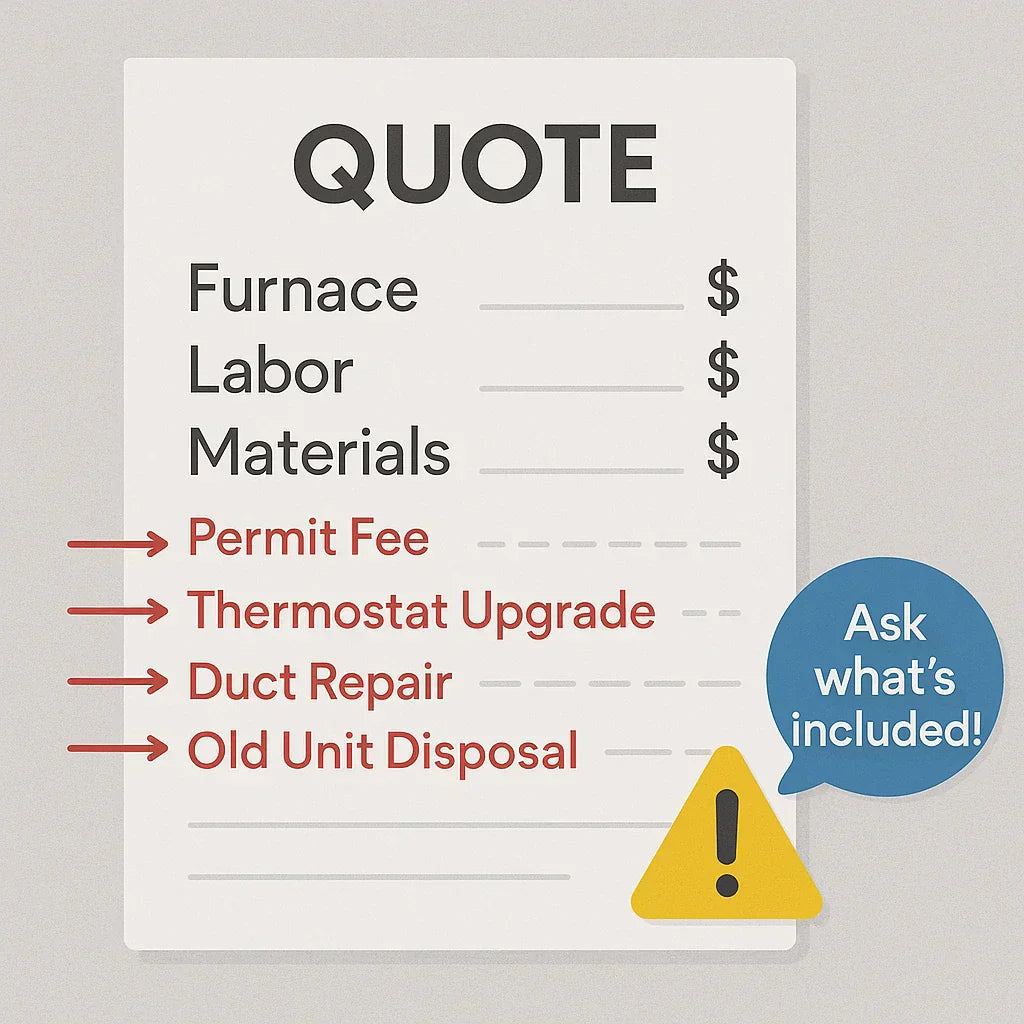By Alex Lane | Your Home Comfort Advocate
So, your furnace is on its way out—or maybe you’re planning a proactive upgrade before winter hits hard. Either way, you’ve done the homework, got a few quotes, and picked a system that fits your budget.
But before you sign that installation contract, here’s the truth: most homeowners overlook 10–30% of the actual cost when replacing a furnace.
In this guide, we’ll shine a light on the hidden furnace replacement costs that don’t always show up on the initial estimate—so you can budget smarter, ask the right questions, and avoid frustrating surprises.
💸 Why Your Furnace Quote Might Not Tell the Whole Story
Furnace quotes usually include the basics:
-
The new furnace unit
-
Removal of the old system
-
Labor for installation
-
Basic reconnection to existing ductwork and thermostat
But there are plenty of items that may be excluded unless you ask. And if they crop up on install day, you could be writing a bigger check than expected.
🛠️ Curious about what the “average” furnace replacement includes? Start with the full breakdown:
👉 How Much Does a New Furnace Cost?
According to This Old House, it’s common for homeowners to focus on equipment cost alone—while ignoring important add-ons that can affect comfort, safety, and energy efficiency.
🧾 Commonly Overlooked Expenses
1. Permit Fees and Local Code Compliance
Depending on where you live, you may need a mechanical permit, inspection, or even an energy compliance form. This can add $100 to $500 to your total cost.
Some contractors include this in their quote. Others don’t. Always ask.
2. Old Furnace Disposal
If your contractor hauls off the old furnace, great. But some charge a $100–$300 disposal fee that may not be listed upfront.
3. Electrical Panel or Line Upgrades
Electric furnaces require high-voltage circuits. Older homes may need:
-
A new breaker or dedicated circuit
-
Upgraded electrical panel
-
Grounding check
Expect to pay $200–$1,000 depending on complexity. Learn more with this furnace install checklist from Superior MSI.
4. Thermostat Replacement or Rewiring
Some older thermostats aren’t compatible with modern high-efficiency or variable-speed furnaces. Upgrading to a programmable or smart thermostat may cost $150–$400, especially if rewiring is needed.
5. New Gas Line or Shutoff Valve
If you're switching from oil to gas—or if your existing line doesn’t meet code—you may need a new gas line extension, shutoff valve, or sediment trap. That could run $200–$600+.
🌬️ Ductwork Repairs or Replacement
Here’s the hidden cost most people don’t see coming: your ducts.
Your new furnace might be 95% efficient, but if your ducts are:
-
Leaking
-
Undersized
-
Poorly sealed or insulated
…you could lose up to 30% of your heated air before it ever reaches your rooms.
According to Energy Star, duct issues are one of the leading causes of HVAC inefficiency. If your system is noisy, uneven, or constantly running, it’s worth inspecting the ductwork during replacement.
Duct repair or replacement can cost anywhere from $500 to $2,500 depending on length, access, and materials.
⚡ Hidden Efficiency Costs
Sometimes the “hidden costs” aren’t dollar-based—they’re performance-based.
Oversized Furnaces
Too big, and your system short-cycles (starts and stops constantly), wearing out parts faster and reducing comfort.
Undersized Furnaces
Too small, and it struggles to keep up—especially during freezing temps.
AFUE Confusion
Many homeowners assume a 95% AFUE furnace will always save more money than an 80% unit. But if your energy usage is low or you live in a mild climate, the difference might not be enough to justify the extra upfront cost.
A proper Manual J load calculation is the only way to match the right system to your home. If your contractor doesn’t do this, consider it a red flag.
Need help understanding sizing? Check out this excellent guide from Australian Energy Upgrades.
✅ How to Avoid Surprise Charges
Here’s what I recommend every homeowner do before signing off on a furnace install:
1. Get a Line-Item Estimate
Make sure your quote clearly lists:
-
Equipment model + warranty
-
Labor cost
-
Thermostat compatibility
-
Disposal fees
-
Permit/inspection costs
-
Any optional upgrades
2. Ask About Ductwork
Will they inspect and seal the ducts? Are repairs included? Don’t assume.
3. Confirm Utility Rebates
Some installers skip this, but you could leave $300–$600 on the table. We'll cover this in detail in the next post:
👉 Furnace Rebates and Tax Credits You Can Claim in 2025
4. Compare Multiple Quotes
Sometimes the “cheapest” quote leaves out half the work. A detailed quote with everything on paper helps you compare apples to apples.
💬 Final Thoughts from Alex Lane
A furnace replacement is more than a plug-and-play job—it’s a major home upgrade that touches everything from your thermostat to your ducts to your monthly bills.
My advice? Don’t just ask what’s included—ask what’s missing. A little upfront clarity can save you hundreds (or thousands) once the job starts.
Alex Lane
Your Home Comfort Advocate







